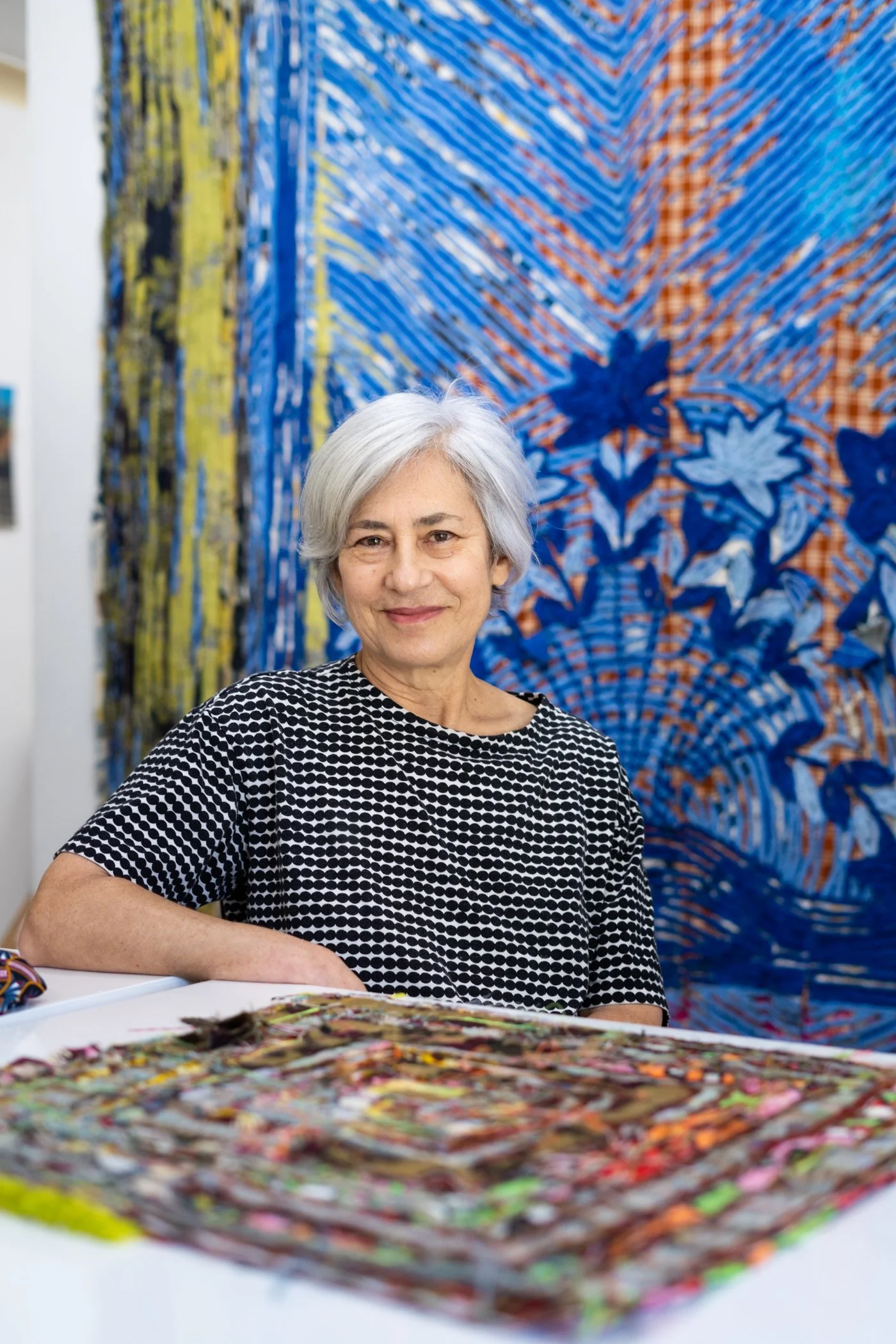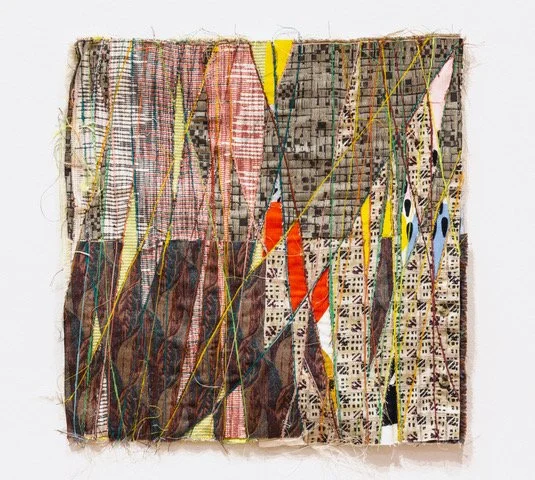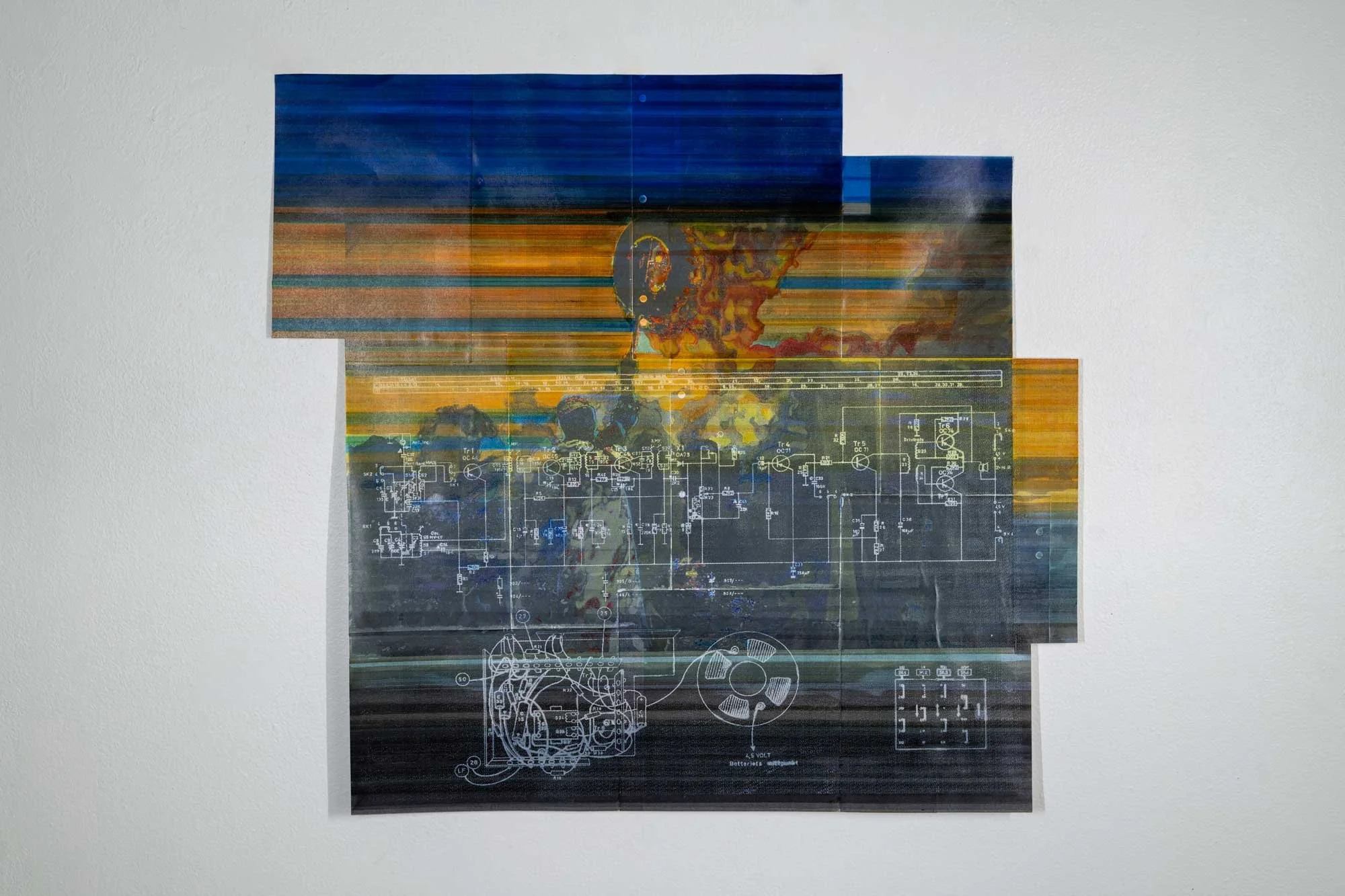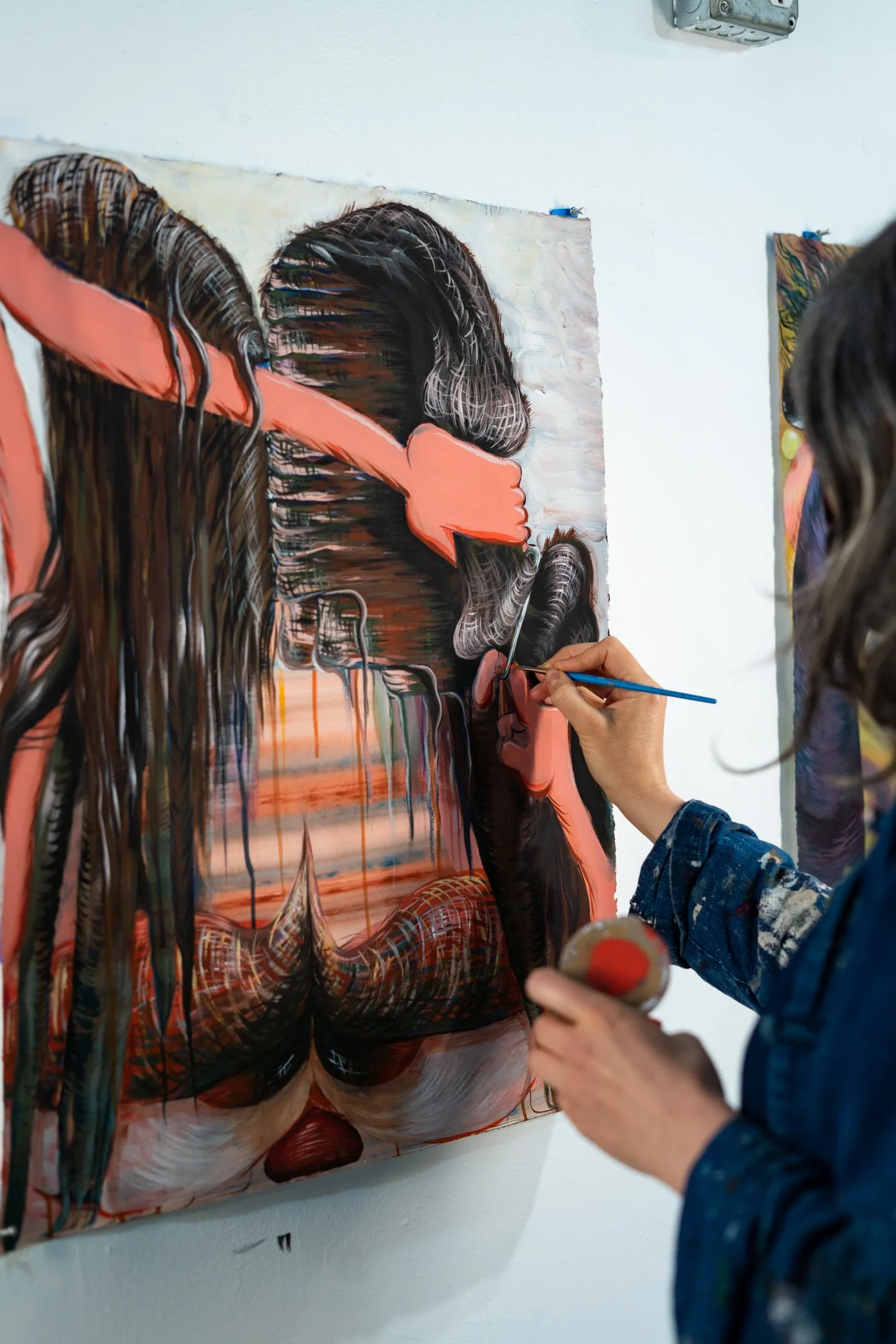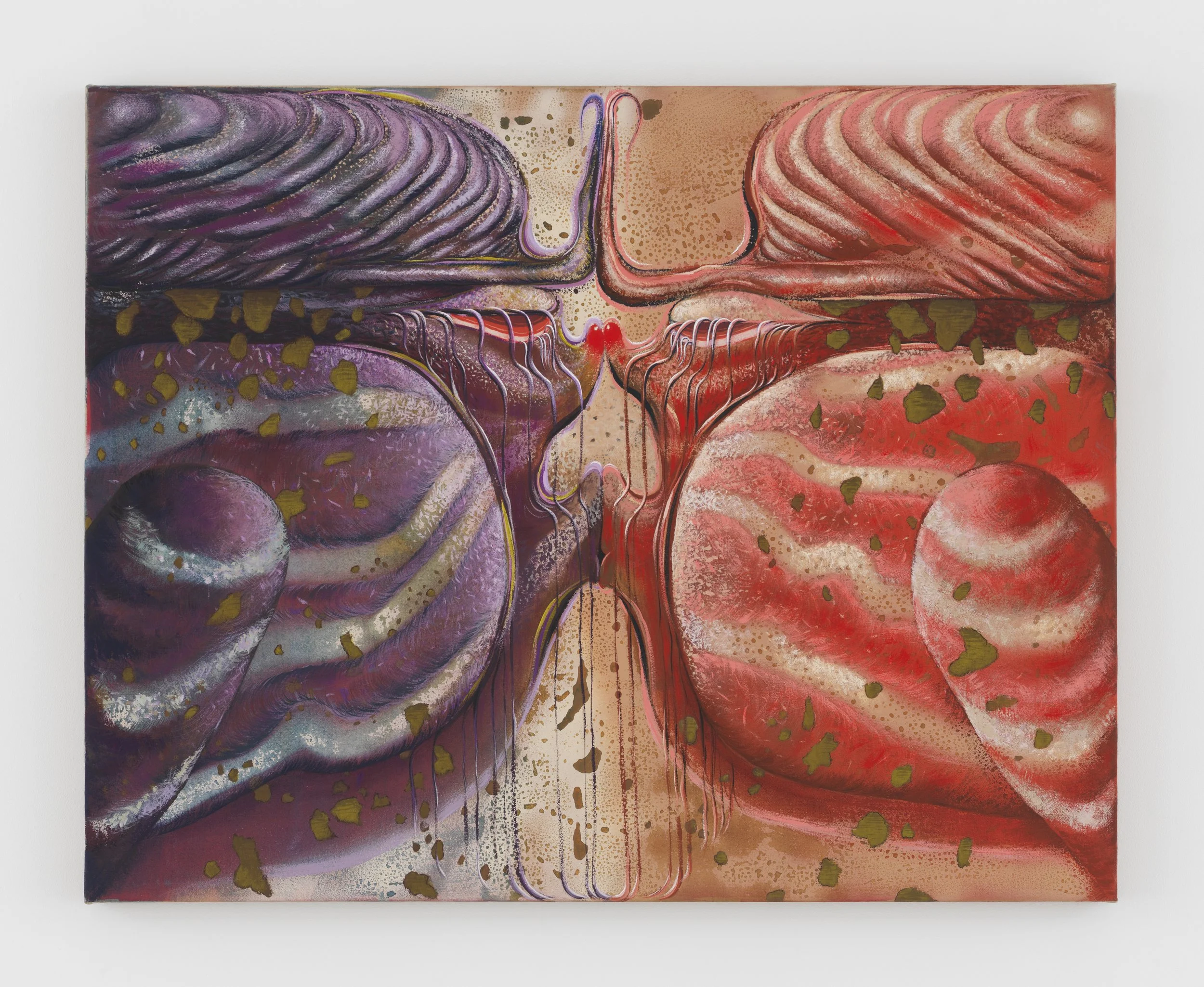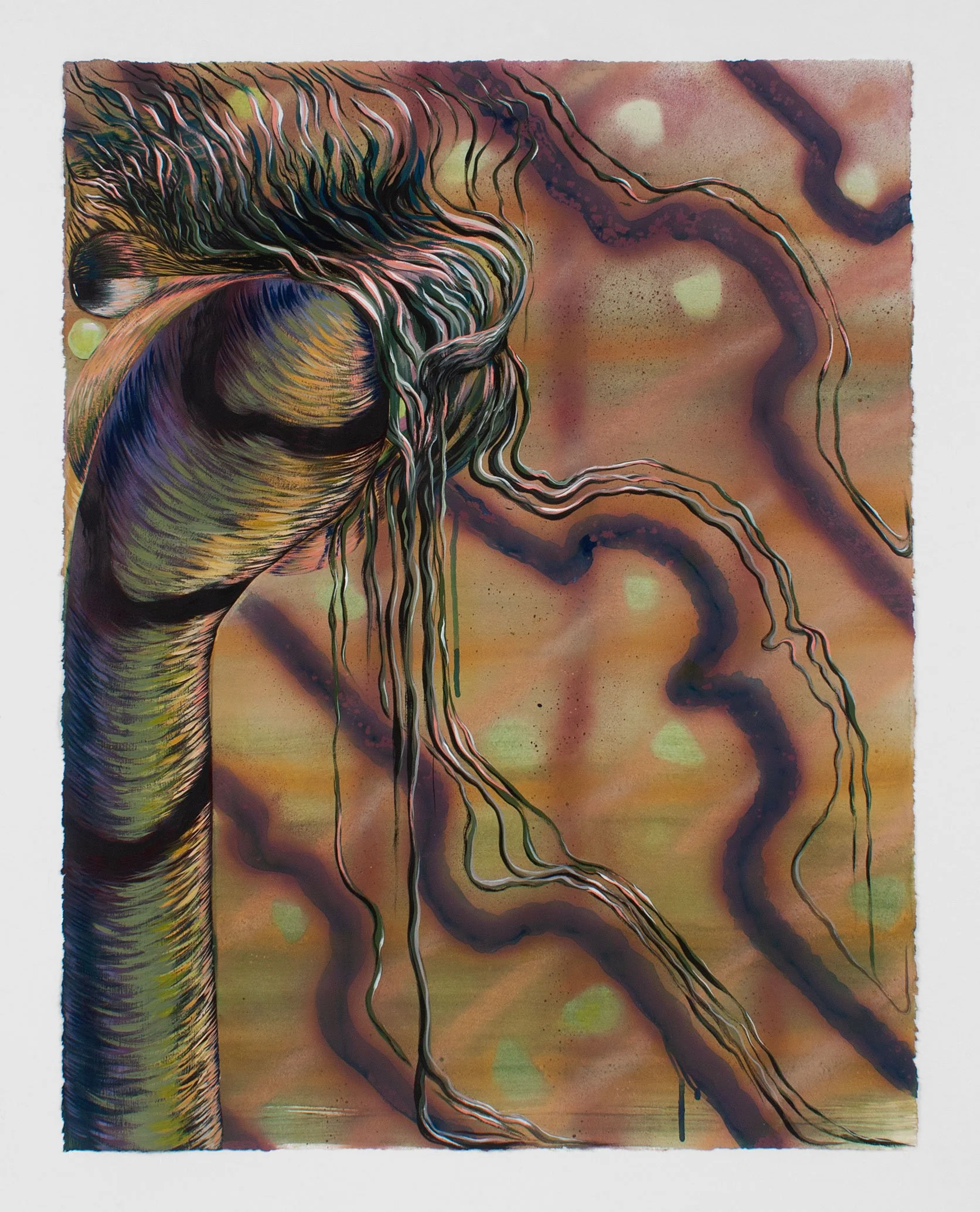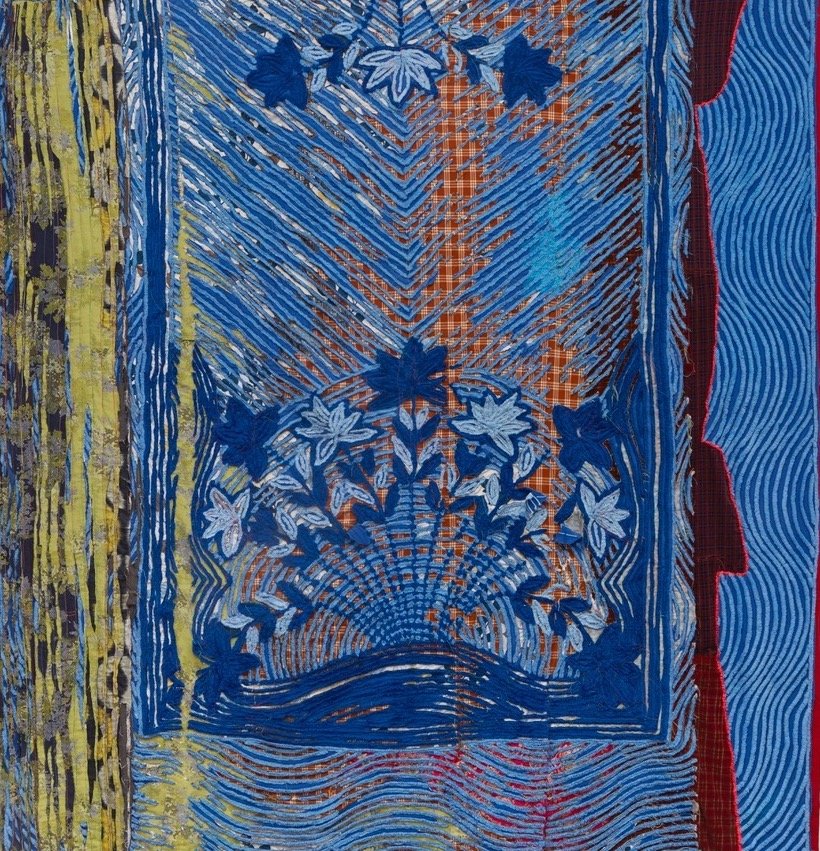
January
Tracing History: How Artists Respond to a Changing World in Their Practice and Their Careers
by Kat Herriman
This month’s residency was generously
sponsored in part by Hesty Leibtag and Terry Verk.
Elana Herzog is a sculptor who is fluent in fabrics and uses them to tell new stories. Bridget Mullen is a painter who fights her way into a painting armed with abstraction and wiggles her way back out by using those uncanny bones to animate her figures. Rodney Ewing is an artist that goes idea first and lets it get as emotionally complicated as it needs to, even if it only physically stays in two dimensions. At first blush, it seems like Herzog (a sculptor), Mullen (a painter), and Ewing (a topic-based artist) wouldn’t share much in common; and then you look closer.
For instance, if you got your hands on their travel details for getting to Fountainhead Residency, maybe you’d learn that they all took off from the East Coast somewhere and that they all arrived with baggage. If you got a chance to talk, you’d probably find out they all went in knowing their Fountainhead experience was not going to be like residencies they’d done before.
This month’s residency was dedicated to multigenerational artists and therefore welcomed artists of an age not entirely typical at your average residency program. After weighing all the upsides and the inputs, you’d realize they all applied to Fountainhead because programs like this, tend to unlock important doors for their practices, creatively and spiritually. Because even though they all treasure moments alone wrestling in their studios with the sauce, they still need other people to give their work meaning and to bend it in those unexpected ways that keep the motor going. What you’d have to conclude is that these are artists who demand layers in all dimensions, who thrive in circumstances where dialogue is encouraged. That is perhaps what made this group of individuals so appropriate for one another and for this session, which sought to focus on their multigenerational wisdom and how to amplify its occurrences and influence.
Mullen is the literalist of the group. She has spent her career hustling herself into circumstances that lend themselves to weekly studio visits with new audiences because this feedback is a key ingredient in her process. It is in fact so essential to her work, that friends often serve as scouts for new opportunities, sending applicable residencies as they arise. She ended up at Fountainhead because she heard good things. Herzog is more abstract in her approach. She likes to try on other people’s eyes but that happens largely through looking at the work of others, going to institutions as well as studios.
During her time with Ewing and Mullen, Herzog enjoyed the camaraderie of looking and what that added to her usual routine. “What made it most interesting to me was having the other two artists to bounce off of. We, on the surface, were all experiencing the same thing. Yet, due to our difference in age and history, we dealt with it slightly differently,” Herzog says.
“It was useful, and revealing for me to be able to check in with the other artists and share our reactions. We have different tools and it was great for me to be reminded of all the ones at my disposal.” Ewing has always engaged other artists and intimates in his process, it is a generative device that has pivoted projects mid-flow, bringing comedy to tragedy and tragedy to comedy. His projects are often social by nature and so actual conversation is not only the subject but a critical ingredient in animating the material. “Most times you talk to maybe two or three peers,” Ewing says. “When you look at [your work] through somebody else’s eyes and you have the chance to have deep and meaningful conversation, that influence is always helpful.” In Ewing’s work, complication is canvas.
While all three artists emphatically praise their time with one another, shared breakfasts, and the myriad of other guests they hosted together, they are unable to trace (at least on command) one concrete snippet of dialogue that challenged or changed a specific artwork’s aesthetic or direction. And together, as if all at the kitchen table, we decide it’s not because it didn’t happen, but because the nature of the exchange we are describing is not education per se but wisdom, and wisdom arrives fully assimilated. Wisdom is information applied. It needs action in addition to acceptance.
Herzog, Ewing, and Mullen are careful listeners but they are also contributors. The artists didn’t have to spend a performative hour workshopping how Gen X and boomers approach image making; they had someone to drink coffee with every morning. They had piping hot energy to bring back to the studio. What could be more empowering?
Elana
Herzog
Elana Herzog is known for abstract, tactile works in which she disassembles, reconfigures, and embeds second-hand textiles in walls, modular panels, and architectural spaces with industrial-grade metal staples. Herzog’s installations blur distinctions between two-and three-dimensional media, eliciting comparisons to late-modernist painting and drawing. Yet, they also upend that tradition through a subversive, deconstructive process that emphasizes ephemerality and fragility. Thematically, Herzog’s conversion of household castoffs into minimalist art raises questions about value, ownership, and high- and low-culture conventions of taste and beauty.
Herzog thinks of her work as domestic archaeology, a process that reveals relationships between textiles, our daily lives, and the larger world. Perhaps that’s why making art, for her, is accompanied by feelings of curiosity, anxiety, and delight. She wants those who see her work to realize that the experience of beauty includes both pain and pleasure. Herzog has been recognized with a Guggenheim Fellowship, Anonymous Was a Woman Award, and Louis Comfort Tiffany Foundation Award, among others. She has exhibited nationally and internationally, including at the Brooklyn Museum, Museum of Arts and Design (MAD), Tang Museum, Weatherspoon Art Museum, and Sharjah Art Museum. Herzog was born in New York City, where she currently lives and works.
From left to right: American Pastoral, 2021. Vintage chenille bedspread, textiles, and sewing thread; A portrait of Elana Herzog in her studio at Fountainhead Residency by Karli Evans; Sampling Today, 2020. Mixed textiles and thread; Herzog’s materials in the studio.
Rodney
Ewing
Rodney Ewing’s drawings, installations, and mixed media works focus on his need to intersect body and place, memory and fact to re-examine human histories, cultural conditions, and events. With his work he is pursuing a narrative that requires us to be present and intimate. Ewing is a storyteller weaving unsung narratives into his diverse practice.
From works on paper to sculpture and installation, Ewing is inspired by artists who effortlessly convert histories and experiences into visual works of art. In Miami, he worked on a series documenting the exploitation of the Black body by industry. His work has been exhibited at The Museum of the African Diaspora in San Francisco, The Drawing Center in NY, and most recently at the Museum of Modern Art, San Francisco, Jack Shainman Gallery - The School, NY, and Rena Bransten Gallery, SF. Ewing is a grantee of the San Francisco Art Commission Individual Artist Grant (2016-2020) and his work has been included in the collection of Tufts University Art Gallery. He was born in Baton Rouge, LA, and currently lives and works in Brooklyn, NY.
From left to right: A portrait of Rodney Ewing in his studio at Fountainhead Residency by Karli Evans; S.O.S, 2022. Unique hand-painted silkscreen on ledger paper, photo credit Karli Evans; Song of the Sparer, 2021. Hand- colored silkscreen on ledger paper.
Bridget
Mullen
Bridget Mullen works free-associatively, without plans, to create paintings and sculptures. Her ceramic work fulfills a curiosity about her characters outside the spatially dense environments in her paintings. In paintings, the figures exist to affect the composition of the ground and the ground exists to affect the composition of the figures. Through alternating color modulation and flatness in disjointed layers and repeating ambiguous imagery, she creates game-like situations in which characters are in a state of becoming, causing paintings to seem self-aware.
Mullen’s works are slow to evolve, with weeks, months, or years passing between decisions. Her paintings begin as abstractions that she then repurposes as figurative works, alluding to the messiness of the human experience and touching on themes of interiority, collective and personal power, and quitting as self-care. Mullen is represented by Shulamit Nazarian in Los Angeles, has recently been featured in Artforum and The Brooklyn Rail, and is the recipient of the 2021 New York Foundation for the Arts Painting Fellowship. She was born in Winona, MN, and currently lives and works in Brooklyn, NY.
From left to right: A Spur, An Array, As Reef, The Chord, 2022. Flashe and acrylic on linen, photo credit Matt Grub; Future Farmers, 2022. Flashe on linen, photo credit Matt Grub; Sluggers, 2022. Flashe, acrylic, and spray paint on linen, photo credit Matt Grub; Mullen painting in her studio, photographed by Karli Evans.
Ewing, Faded, 2022. Unique hand-painted silkscreen on ledger paper. Photo credit Karli Evans.
Ewing, Hidden, 2022. Unique hand-painted silkscreen on ledger paper.
Ewing, Sundown, 2022. Unique hand-painted silkscreen on ledger paper. Photo courtesy of the artist.
Herzog, Untitled, 2021. Vintage chenille bedspread, mixed textiles, embroidery floss, and sewing thread.
Herzog, Sampling Today, 2020. Mixed textiles and thread.
Mullen, Cave, 2022. Flashe and acrylic on paper.
Mullen, Birthday Series #48, 2022. Flashe on linen.
Mullen, Iridescent And Not Gonna Take It Anymore, 2022. Flashe and spray paint on paper.

